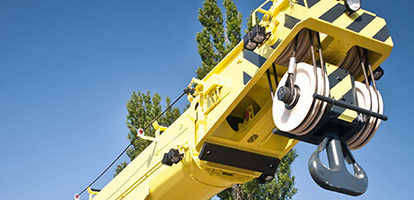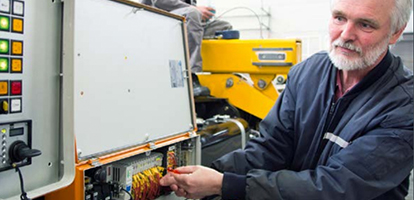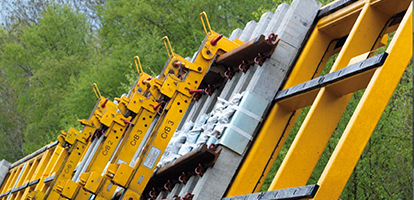



Once the railroad cranes and slag pot carriers leave Kirow’s production hall in Leipzig, Germany, they will undoubtedly endure 20 years or more in the most demanding conditions. Outdoor temperatures between -20 and +40 °C, hot slag material with temperatures of up to 1,200 °C, severe shocks and increased electrical voltages are just some of the demands placed on the technology and electronics aboard the heavy-duty machinery. In this environment, WAGO’s Spring Pressure Connection Technology and I/O controllers have proven themselves.
Kirow is the world market leader for railway cranes, and its heavy-duty model, the Multi Tasker, can be found in the depots of many railway companies. It is used whenever damaged vehicles have to be recovered from the rail network and loads of up to 200 t have to be moved. The Tracklayer, a specialty lifting and transportation machine that accompanies the Multi Tasker, is used for laying very long and heavy track and replacing switch points. Both pieces of equipment must be regularly replaced due to severe wear that results from use with highspeed trains. Previously, the individual parts of a rail’s switch point were transported to the site, where they were assembled and fitted to the tracks. The heavy switch segments, which weigh up to 18 t, are now supplied by the manufacturer as completely pre-assembled components that are brought to the replacement site. As the switches are too bulky for normal rail transport (they are up to 4.4 m wide), they are loaded onto Kirow’s special switch transport cars, tilted 60 degrees, fastened securely and then transported to the site — often over long distances.
Rugged Electronics for Harsh Environments
Kirow’s railway cranes and slag pot carriers are operated by sophisticated control technology. A host of sensors monitor the real-time operating status and numerous actuators ensure reliable control. The signals are routed by an I/O system that supports several essential functions, such as the use of inductive sensors to monitor the position of additional stabilizing supports for a crane. If the supports are located at the required distance, then a digital output module in the system activates a control light. Other sensors check whether the tilt compensation mechanism is correctly locked during transport and unlocked during operation. “We were looking for an I/O system that had already been tried and tested in the harsh railway environment. Compared to other manufacturers, WAGO’s reliable Spring Pressure Connection Technology and robust CANopen technology stood out,” reports Arnfried Wagner, the engineer responsible for control technology at Kirow. And this is why Kirow uses the WAGO-I/O-SYSTEM 750. The Minden-based controls manufacturer was able to certify the durability of its technology for the special requirements of the railway industry according to EN 50155 (railway standard) and EN 50121/3/2 (EMC performance). WAGO’s Spring Pressure Connection Technology and its electronics have been tested for resistance to impacts and shock; they also have the certifications that demonstrate resistance to extreme weather, interference and vibrations, as well as dielectric strength.
According to Wagner, the other benefits of WAGO technology include a modular design and a compact footprint. The space-saving I/O nodes can be positioned wherever sensors and actuators are required, and do not require expensive cabling to a central controller. Due to the short distances involved, Kirow uses cables with small cross sections that are less susceptible to electromagnetic interference. Thanks to the large number of analog and digital inputs and outputs available, the WAGO-I/O-SYSTEM is the prefect complement to Kirow’s own control technology. This is why additional functions, such as the movement of the support arms, will also be controlled by the WAGO-I/O-SYSTEM’s output modules in the future.
Increasing Demands on Technology
“We have been using WAGO technology for five years and are very pleased with it. We have never had any failures despite the extreme environment in which it is used. This technology can be flexibly applied to a wide range of requirements and has a good price/performance ratio,” Wagner says. Based on its performance and reliability, the engineer responsible for the control technology at Kirow rates WAGO an A+. “We initially underestimated the problems with condensation in areas with extreme temperature fluctuations. We partnered with WAGO to find a solution and quickly found one by applying a special, protective lacquer to the electronics. Since then, we have not had any more problems with humidity and our customers are also very pleased with the technology’s reliability,” Wagner beams.
At Kirow, particular importance is placed on standard interfaces, like the fieldbus coupler for CANopen; usability is also stressed. Despite continual operation in harsh environments, WAGO’s Spring Pressure Connection Technology has ensured absolute reliability for both modules and controllers. “The extended temperature range is becoming increasingly more important to us. For example, we have tenders from Lithuania and China in which the technology has to function flawlessly at -40 °C. WAGO’s new 750 XTR Series offers the right solution here,” reports Wagner. The new WAGO-I/O-SYSTEM 750 XTR features an extended temperature range from -40 °C to +70 °C. This system also offers isolation up to 5 kV and vibration resistance up to 5g of acceleration.
At Kirow, experience has shown that having proven technology is not enough. Compliance with standards for climatic conditions, EMC protection and proof of safety must also be certified. With its own certified testing laboratory, WAGO is able to reliably verify compliance with all standards.
Compatibility and Long-Term Availability
The customers of the railway technology manufacturer expect a product life cycle of at least 20 years. Quality of service and spare part availability are also large parts of what customers expect. However, the innovation cycle of software and electronic components is not conducive to these requirements. The control technology manager at Kirow has had several disappointing experiences with electronics suppliers, “We were repeatedly surprised by the discontinuation of important parts. WAGO’s product philosophy in this regard is much better, as new components are always backward compatible with previous versions. This continuity is also very important to us,” Wagner concludes.
Text: Marco Schrader, WAGO
Photo: Kranunion/Kirow, WAGO